By Janice Tucker with thanks to Barbara Goede for sharing her knowledge and notes, which contributed to this article.
Photos: Barbara Goede, Linda Churchill, Don Nofte and Janice Tucker
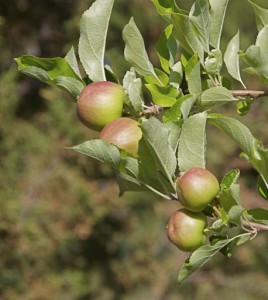
Golden delicious apples (Janice Tucker)
There are many varieties of apples to choose when deciding to plant in a home garden or orchard. The Santa Fe climate is friendly to a nice selection of apple varieties. The Santa Fe Botanical Garden planted the Ginger Gold and Red Jonathan varieties in their Goede Family Orchard located on Museum Hill. Check with local nurseries and tree farms for a larger list of options. Apples must cross-pollinate in order to produce. Two trees of the same variety do not work for cross-pollination. Select a different apple tree as a pollinator, making sure that it is not a variety that has sterile pollen. Nurseries and tree farms usually serve as excellent guides in helping to make the choices of varieties and pollinator trees. Several good internet sites offer helpful advice and tips. Crabapples can be used as pollinator trees as long as they bloom at the same time as the varieties being planted.
Spring is the best time for planting fruit trees in Santa Fe. Select a young tree from a reputable nursery or tree farm. Look for a 4 to 6 foot tall tree that has a healthy root system. A larger tree can be transplanted but a smaller tree usually handles the transplant process better. Plant the tree immediately so that the roots do not dry out.
The time spent in selecting varieties that will do well in the local climate and in planting the tree properly will help to avoid problems down the road. At the end of this article is a list of recommended reading to consult for follow-up care of apple trees after planting.
Selecting the site:
Apple trees must be planted in an area with full sun, free of shading from large trees or buildings. Choose a location that allows for the trees to grow without crowding. Pull up any nearby grass or weeds so that they do not compete with the new tree for water and food.
Although apple trees need a certain number of chill hours (32 to 45 degrees F) in the winter, a spring cold snap can kill the apple blossoms before they set fruit. Try to plant the trees so they are not in low-lying areas where cold air tends to collect. Planting trees on a slope will allow air to flow downward and away from the trees. Avoid any areas that can create cold pockets. (See Spring Cold Snaps under A Few Hints below.)
Most well-draining soils work for apple trees as long as they have good nutrients and proper pH. Some good soil enhancements are seaweed, compost and additives that provide beneficial endo and ecto Mycorrhizae rhizomes and bacteria. Nurseries and tree farms can offer more advice on nutrients and the proper pH. Heavy soils that retain water are not good choices for apple trees. Apple roots do not like to stand in water.
Planting the tree:
- Dig a hole at least twice as wide and deep as the root spread. Be aware that the bulge where the apple variety has been grafted to the rootstock at the base of the tree should be about 2 inches above the earth.
- Sprinkle some of the soil mixed with the amendments back into the hole and loosen the walls of the hole to allow the roots to easily spread and grow.
- Place the tree in the hole, positioning it so that it is straight and the bulge where the apple variety has been grafted to the rootstock is facing north (facing north helps prevent sun damage). Spread the roots on the loose soil, checking to see that they are not twisted or crowded. Continue to cover the hole with soil, pressing the soil firmly so it covers the roots and fills in air pockets. It is important to pack the soil snugly around the roots to anchor the tree. Do not add fertilizer at planting time as it can burn the roots. Continue to fill the hole loosely with soil to allow water and air to reach the roots. Again – and this cannot be stressed too much – be sure that the bulge where the apple variety has been grafted to the rootstock is about 2 inches above the ground and facing north.
- After planting the tree, water thoroughly to close air pockets and to ensure the roots and soil are packed in together. Check with local experts to determine a watering schedule. Consider installing a drip system. If rabbits, deer or other wild critters are nearby, cover the trunk with hardware cloth or a trunk protector until the tree ages. Otherwise, the animals can (and will) remove the bark, which will kill the tree.
- Once the tree is planted and watered, make a shallow depression about 2 feet in diameter around the base of the tree so it can collect and funnel water to the roots.
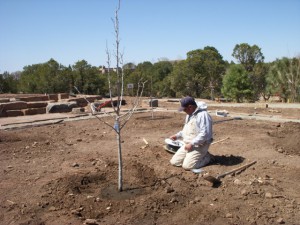
Apple tree hole size and depression (Barbara Goede)
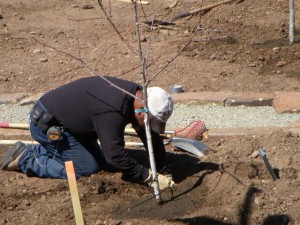
Installing irrigation (Barbara Goede)
- Beam with pride when the tree has put out leaves for the first time…you did good!
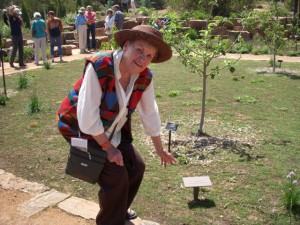
Barb by Apple Tree (Don Nofte)
To learn more about the apple process from flower to fruit, see the Apple Blossom plant of the month article for April 2014.
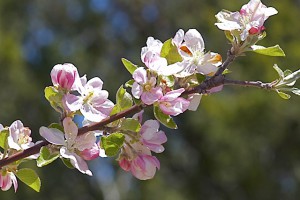
Apple blossom on branch (Janice Tucker)
A Few Hints:
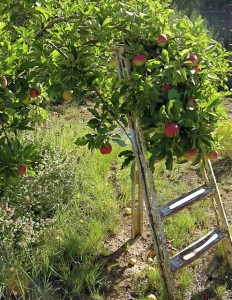
Apples and Ladder holding up the fruit (Janice Tucker)
The first 3 to 5 years of a new fruit tree need to be devoted to developing the root and tree structure. This allows the roots to become larger and strong enough to feed the tree so that the branches can easily hold the weight of the fruit. Avoid allowing a full crop to develop the first few years. During this time, it is okay to allow 1 or 2 fruits to grow in order to offer a taste sample. Any excess fruit is easily removed by pinching it off when it is the size of the end of one’s little finger.
In addition, generally speaking, home growers are prone to letting even older trees overproduce and tend to shy away from thinning out early fruit. Be brave. Thin the apples when they are young. The tree will be healthier and there will still be plenty of fruit to enjoy.
Spring Cold Snaps: While commercial growers use either fans to keep the cold air moving away or hire a helicopter to hover over the orchard keeping the warm air down over the trees, that process is a little more than a home orchard owner can handle. Even then the results are iffy. There really are no guarantees, but the following suggestions might work to protect the apple fruit during a spring cold snap. The coldest part of a day is usually in the early morning hours between 4 to 6 a.m., so the following suggestions should be carried out the evening before:
Preventive Method 1: The easiest thing to do is to spray the trees with water until dripping is evident. The water will freeze, insulating the apple blossoms and protecting them from the freezing temperatures.
Preventive Method 2: If trees are dwarf and very small, cover them with blankets or several layers of heavy grow cloth.
Even if these methods do not work, at least it leaves you feeling that you tried and did your best. Sometimes
these methods help, sometimes not.
Now go hug one of those those apple trees you planted and watch it grow!
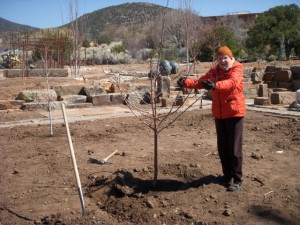
Barb gives tree a hug for luck by Linda Churchill
Recommended Reading: All About Growing Fruits & Berries, Ortho books
Apples: History, Folklore, Horticulture and Gastronomy, by Peter Wynne
Apples, by Frank Browning
All About Apples, by Alice A. Martin
Pamphlets:
The Biodynamic Treatment of Fruit Trees Berries and Shrubs, by Ehrenfried E. Pfeiffer
Establishing and Managing Young Apple Orchards, from U.S. Dept. of Agriculture
Growing Tree Fruits in the Home Orchard, from Univ. of Illinois College of Agriculture
Sources:
Wynne, Peter, Apples: History, Folklore, Horticulture, and Gastronomy. New York, Hawthorne Books, Inc. 1975.
Goede, Barbara, Notes on Planting. Notes on Protecting from a Spring Frost.
Parker, Michael, Growing Apple Trees in the Home Garden. North Carolina Cooperative Extension Service.
www.ces.ncsu.edu.
Mother Earth News Editors. Planting Apple Trees. Mother Earth News, www.motherearthnews.com.


